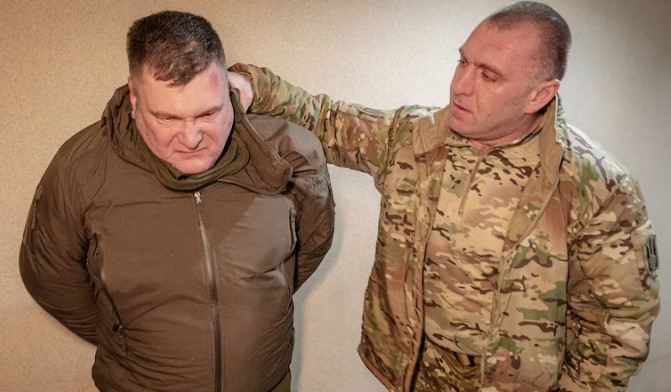High-Ranking Security Official Exposed as Russian Spy
A senior official from Ukraine’s Security Service (SBU) has been arrested on suspicion of being a Russian agent. This individual held an important position in the Anti-Terrorist Center, a unit responsible for protecting Ukraine from internal and external threats. The arrest was part of a secret operation named “Rat,” which was carried out with high precision by Ukrainian intelligence.
The suspect had been serving in this role since 2016, making him a trusted figure within the organization. However, investigations revealed that he had been secretly providing classified information to Russian intelligence for years. The Ukrainian government confirmed that this was a major breach of national security.
On Wednesday morning, security forces took swift action, detaining the suspect before any further damage could be done. The head of the SBU personally oversaw the operation, emphasizing its seriousness. Photos shared on social media showed the moment the suspect was taken into custody. This arrest has raised concerns about the presence of Russian spies in Ukraine’s most critical institutions.
How the Spy Was Discovered
The investigation leading to the arrest was one of the most complex counterintelligence operations in recent years. Ukrainian authorities had been closely monitoring the suspect for months, using a combination of advanced surveillance techniques, including audio and video recordings.
Security officials gained access to the suspect’s mobile phones and computers, allowing them to track his activities and gather crucial evidence. Through intercepted communications and digital forensic analysis, investigators discovered that the suspect had shared classified information with Russian intelligence at least 14 times.
Although officials have not disclosed the exact nature of the leaked information, it is believed to include military strategies, security protocols, and possibly the locations of key Ukrainian forces. Such intelligence could provide a significant advantage to Russia, endangering Ukrainian military operations and national security.
The suspect’s actions were carefully analyzed, and once enough evidence was gathered, Ukrainian authorities acted quickly. The operation was conducted under strict secrecy to prevent any chance of the suspect escaping or destroying evidence. The success of this mission highlights Ukraine’s growing ability to detect and neutralize threats from within.
Ukraine’s Fight Against Russian Espionage
Since the start of the full-scale invasion in February 2022, Ukraine has been aggressively working to eliminate spies and collaborators within its borders. The government has arrested hundreds of individuals suspected of working with Russia, with many accused of passing critical intelligence, aiding Russian military operations, or attempting to sabotage Ukraine’s defenses.
Russian intelligence agencies have a long history of infiltrating foreign institutions, particularly during times of war. By placing spies in strategic positions, they aim to weaken their enemies from within. Ukraine has responded by strengthening its counterintelligence operations, introducing tighter security measures, and closely monitoring individuals in sensitive roles.
The arrest of this high-ranking official highlights the enormous challenges Ukraine faces. The country is not only fighting a war on the battlefield but also a hidden war against espionage. Identifying and eliminating spies within critical institutions remains a top priority for Ukrainian intelligence agencies.
Authorities are now conducting a detailed investigation to determine the full extent of the damage caused by the suspect’s espionage activities. Official security personnel are analyzing intercepted communications, classified documents, and digital records to identify what sensitive information was leaked. Each piece of intelligence sent to Russia could have influenced military strategies, exposed critical defense operations, or compromised Ukraine’s ability to counter enemy attacks.
Investigators are also working to identify any possible accomplices who may have assisted the suspect in gathering and transmitting information. Given his senior position, there is concern that he may have operated within a network of spies rather than acting alone. Official authorities are reviewing financial transactions, communication logs, and internal security breaches to uncover any additional threats within Ukraine’s intelligence agencies.
Despite Ukraine’s ongoing efforts to strengthen counterintelligence, the risk of espionage remains high. Russian intelligence agencies continue to deploy covert operatives to infiltrate key institutions, making constant vigilance essential. The success of Operation “Rat” highlights Ukraine’s growing capability to neutralize internal threats, but it also serves as a reminder that protecting national security requires continuous monitoring, intelligence-sharing, and strict official security protocols.

